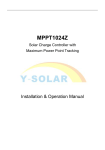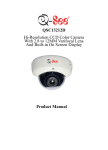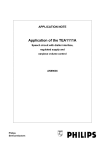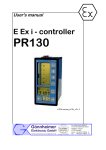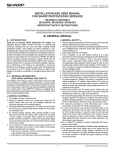Download MPPT2024Z User`s Manual
Transcript
MPPT-10 Solar Charge Controller with Maximum Power Point Tracking Installation & Operation Manual www.biall.com.pl Content 1. Safety Instructions......................................................................................... 3 2. MPPT Controller Instructions......................................................................3 2.1 Overview....................................................................................................3 2.2 Structure....................................................................................................4 2.3 Functions.................................................................................................. 4 2.4 MPPT technology Instructions............................................................6 3. PV System Planning Reference.................................................................. 8 3.1 System Voltage........................................................................................ 8 3.2 Solar Modules Configuration...............................................................8 3.3 Wire Sizing................................................................................................ 9 3.4 Over Current Protection......................................................................10 3.5 Lightning Protection............................................................................ 10 3.6 Grounding............................................................................................... 11 3.7 System Expansion................................................................................11 4. Installation...................................................................................................... 11 4.1 Dimensions............................................................................................. 11 4.2 Connecting Diagram............................................................................ 12 4.3 Wiring....................................................................................................... 12 4.4 Installation Process............................................................................. 13 5. Operation Instructions................................................................................ 13 5.1 Button Function.................................................................................... 13 5.2 LED Displays..........................................................................................14 5.3 System Voltage Indication..................................................................14 6. Faults and Remedies................................................................................... 14 6.1 Protection Remedies........................................................................... 15 6.2 Common Faults and Remedies........................................................ 16 7. Technical Data............................................................................................... 17 8. Quality Assurance........................................................................................ 18 1 www.biall.com.pl Dear Consumer: Thank you very much for using our product! We will offer you the permanent and reliable service for your solar system! The manual gives important recommendations for installing and using the MPPT controller. Please read the manual carefully and thoroughly before using this product. 2 www.biall.com.pl 1. Safety Instructions (1) The controller is only designed to be connected to the off-grid solar system. It offers the management of charging and discharging for the lead-acid battery of flooded, gel and AGM chemistries from 12V to 24V nominal only. Do not connect this controller to other system, such as mains supply and windmill generator. (2) The controller is intended for indoor use only. Protect it from direct sunlight and place it in a dry environment. (3) Batteries generate explosive gases during normal operation. It is important never allow a spark or flame in vicinity of battery. (4) Be sure to always keep children away from batteries and acid! (5) Do not disassemble the MPPT controller, it does not have any user-serviceable parts. (6) The controller warms up during normal operation. Do not touch the heatsink at the bottom of the controller. Note: It is important that the battery is fully charged frequently (at least monthly). Otherwise the battery will be permanently damaged. 2. MPPT Controller Instructions 2.1 Overview MPPT-10 solar charge controller is multi-stage Maximum Power Point Tracking (MPPT) photovoltaic battery charge controller with our own technology. It’s main topology adopts in Buck conversion circuit, and uses MCU to adjust the solar panels working point intelligently in order to make the solar panels output its maximum power. When the circumstances change, the working point of solar panels deviate from the maximum power point, MCU will adjust the solar panels working point based on MPPT calculation to make the solar panels back to the maximum power point again(refer to Chapter 2.4 about MPPT technology introduction). Compared with PWM controller, MPPT controller can increase the output power of solar panels by 5%~30%. The output power increasing proportion is affected by the factors such as solar panels property, humidity and light intensity. The controller uses wall-mount installing (refer to Chapter 4.1). Connecting terminal makes the wiring area bigger and wiring loss less. 3 www.biall.com.pl 2.2 Structure ① ② ③ ④ ⑤ 1 Bottom Heatsink 2 Indicators and Reset key 3 Solar Terminal Block 4 Battery Terminal Block 5 Load Terminal Block Figure 2-1: Controller Structure Diagram 2.3 Functions (1) Maximum Power Point Tracking technology The controller uses Buck conversion circuit and MCU technology to track the maximum power point to implement the maximum output power of solar panels in different illumination intensity and temperature. The MPPT algorithm increases efficiency of your PV system and decreases the quantity of solar panels. (2) Multi-stage Charge Control The starting charging voltage of battery is different, the controller will use the different charging strategies to finalize the charging process. When starting charging voltage of battery is lower than 12.4V (for 12V battery), battery will go through three stages as Bulk, Absorption and Float charging. When starting charging voltage of battery is higher than 12.4V (for 12V battery), battery will go through two stages as Bulk and Float charging. Bulk Charge: The controller charges the battery by its maximum output current. It is at maximum power point tracking state at this phrase. Absorption Charge: The controller begins to limit the charging current to make the battery voltage fixed at a settled absorption voltage (this voltage has temperature compensation) for 2 hours. It increases the charging saturation level of 4 www.biall.com.pl battery and prevents battery from leaking gas, and this can increase the lifetime of battery. Float Charge: The battery is at saturation state, and the controller charges the battery at a trickle current to make the battery voltage fixed at the settled float charging voltage (this voltage has temperature compensation). U Bulk 12.0V 2h U Absorption Float t Figure 2-2: Three-stage Charge Bulk 12.4V Float t Figure 2-3: Two-stage Charge (3) Charge Voltage Temperature-compensated The controller will compensate the Float charging voltage and Absorption charging voltage by -4mV/Cell/°C based on the current battery temperature. For 12V battery, the compensated voltage U=(t-25)*6*(-0.004)V For 24V battery, the compensated voltage U=(t-25)*12*(-0.004)V (4) Discharge Control The controller monitors the battery voltage all the time. The load will be switched off when the voltage less than the Low Voltage Disconnect (LVD) point, and it won’t be switched on until the voltage more than the Low Voltage Reconnect (LVR) point. (5) Protection against Reverse Connected Battery Connecting the battery to the controller by reversed polarity (under the circumstances of solar panels disconnected) will not damage the controller. The controller will work normally after connecting with correct polarity. (6) Protection against Reverse Connected Solar Modules Connecting the solar modules with the controller by reserved connection will not damage the controller. The controller will work normally after connecting with correct polarity. (7) Reverse Current Protection The controller prevents reverse current from flowing into the solar modules 5 www.biall.com.pl at night. An additional reverse current diode is not required. (8) Overtemperature Protection If the temperature inside the controller becomes too high, then the controller will stop charging to the battery, and it will restart charging the battery again when the temperature decreases to a certain value. (9) PV Overvoltage Protection If the input voltage of solar panels exceeds the maximum voltage permitted by the controller, it will enter into protection state automatically and stop charging. When the input voltage recovers to the normal range, the controller will start charging again. (10) Current-limited for Excessive Charging Current If the permissible charge current is exceed, the controller will deviate from the maximum power point to limit the output current to prevent the controller being damaged. (11) Load Output Overload Protection If the permissible load current is exceed, then the load output is switched off. The overload current vs. duration shows as follows: Rate of Current Duration (s) 1.1Irate ≤I< 1.2Irate 120 1.2Irate ≤I< 1.5Irate 60 1.5Irate ≤I< 1.8Irate 10 I≥ 1.8Irate 0.2 Note: Irate=10A, nominal load current The controller restarts the load every 3 minutes automatically, but the user can also restart the load by the Restart key. 2.4 MPPT technology Instructions Solar panels are nonlinear materials, and the output power is mainly affected by illumination intensity, solar panels temperature and load impedance. When the illumination intensity and solar panels temperature are fixed, the output power of solar panels is only affected by load impedance. Different load impedance will make the solar panels work at different point and put out the different power. The following figure will mark the four working points A, B, C, D, and the working point features as follows: 6 www.biall.com.pl Working point D: Output voltage is 22.3V, output power is 0W. This point is the open circuit point of solar panels. Working point C: Output voltage is 0V, output power is 0W. This point is the short circuit working point of solar panels. Working point A: Output voltage is 13V, output power is 74W. This working point is the state when using normal controller, and the solar panels voltage is clamped to 13V by battery. Working point B: Output voltage is 17.6V, output power is 92W. This point is the state when using MPPT controller. Because of using power conversion technology, the solar panels voltage is not clamped by battery and still works at maximum power point. Compare working point A & B, it is easy to find using MPPT controller can increase the using efficiency of solar panels. Compared to normal controller, MPPT controller can generate more power. Figure 2-4: Voltage-Current Curve 7 www.biall.com.pl Figure 2-5: Voltage-Power Curve 3. PV System Planning Reference 3.1 System Voltage The common system voltage of solar system has 3 types: 12V, 24V and 48V. The higher the system voltage, the more power the system can handle. In reality application, user should consider the load power, and the voltage scope permitted by load, and then confirms which system voltage you should use. The power range for each system voltage is as follows: System Voltage Recommended Power Range 12V <800W 24V <2000W 48V <6000W Table 3-1: System voltage vs. Power range 3.2 Solar Modules Configuration MPPT-10 controller can be connected with Single Crystalline Silicon solar panels and also Thin-film solar panels. When configuring the system, make sure the open circuit voltage of solar panels array is not higher than the maximum voltage permitted by the controller. Table 3-2 introduces the models of Single Crystalline Silicon solar panels and Thin-film solar panels and their parameters. Table 3-3 shows the configuration solution for 12V, 24V and 48V system for solar panels. 8 www.biall.com.pl Code Category Pmax Voc Isc Vpmax Ipmax 140W-01 Single Crystallin e Silicon Module 140W 22.4V 8.33A 17.6V 7.95A 14W-0W-02 Thin-film Module 140W 29.0V 7.12A 23.0V 6.52A 190W-01 Single Crystallin e Silicon Module 190W 45.2V 5.65A 36.6V 5.2A 130W-01 Thin-film Module 130W 60.4V 3.41A 46.1V 2.82A The above parameters are for condition of 25°C, AM1.5 spectrum, and 1000W/m2 illumination intensity. Table 3-2: Solar Panels Model and Parameters Code For 12V System For 24V System For 48V System 140W-01 N in parallel two in series, N in parallel four in series, N in parallel 140W-02 N in parallel two in series, N in parallel four in series, N in parallel 190W-01 N in parallel N in parallel two in series, N in parallel 130W-01 N in parallel N in parallel two in series, N in parallel N means the quantity number required by the output current. Table 3-3: Solar Panels Model and System Configuration Solution 3.3 Wire Sizing The maximum input and output current of MPPT-10 is 10A. To ensure the cable temperature does not exceed the safety range, the copper cable’s area must be at least 2.5mm2. In reality application, user can choose the appropriate cables according to the system voltage, permitted cable 9 www.biall.com.pl temperature, cable voltage drop and also cable material. We suggest customer to control the maximum battery voltage loss under 1.5%, and control the maximum voltage loss of solar panels under 2.5%. The following is the cable length between controller and battery, and the suggested copper cables: Cable Cable Size Cable Size Length in mm2 in AWG 1m 2.5mm2 2m 4m Voltage Loss at 10A (a pair) Battery Voltage Loss 12V 24V 48V #13 AWG 0.14V 1.2% 0.60% 0.30% 4mm 2 #11 AWG 0.18V 1.5% 0.75% 0.38% 6mm 2 #9 AWG 0.24V 2.0% 1.0% 0.50% Table 3-4: Cable Length & Cable Voltage Drop The following is the cable length between solar panels and controller, and also the suggested copper cables: Cable Length 2m 4m 8m Cable Size in 2 mm 4mm 2 6mm 2 2 10mm Cable Size in AWG Solar Panels Voltage Loss Voltage Loss at 10A (a pair) 17V 34V 68V #11 AWG 0.18V 1.1% 0.53% 0.26% #9 AWG 0.24V 1.4% 0.71% 0.35% #7 AWG 0.29V 1.7% 0.86% 0.43% Table 3-5: Cable Length & Cable Voltage Drop 3.4 Over Current Protection The electrical equipment used in power circuit must be equipped with over current and short-circuit protection devices, and there is no exception for MPPT-10 controller. The controller adopts in the design of common positive pole inside. We suggest users to install over-current breaker or fuse on the negative loop of solar panels input, and also the negative loop of battery output. The capacity of over-current breaker or fuse is 1.25 times of the rated current. 3.5 Lightning Protection It is the same as other electrical devices that MPPT-20 controller will be damaged by lightning. The controller has limited surge absorption capacity. We strongly suggest users to install lightning surge absorption devices to increase the reliability of the system. 10 www.biall.com.pl 3.6 Grounding Use 4 mm2 yellow and green cable to connect any of the positive terminal of the controller to the ground bus of the system. This can decrease the electromagnetic interference in a certain value. 3.7 System Expansion If you want to deploy a bigger system, you can expand the system by paralleling several sets of the same controller. More controllers can share with one battery group, but each controller must be connected with the independent solar panels array and the independent load. (Please contact the local distributor for further information.) 4. Installation 1. Protect the controller from direct sunlight or other source of heat. 2. Place the controller in a dry environment. 3. A free space of at least 15cm on all side of the controller must be provided. 4. Mount the controller as close as possible to the batteries. 4.1 Dimensions Figure 4-1: Dimensions (Unit: mm) 11 www.biall.com.pl Mounting hole pitch: 60mm*178mm Mounting hole diameter: Ф5mm Height*Width*Thickness: 92.5mm*188mm*55.3mm Connecting terminals: Maximum 6mm² 4.2 Connecting Diagram Temperature Sensor Fuse ③ ① ② Figure 4-2: Connecting Diagram 4.3 Wiring A、Choose the appropriate cables requested as Chapter 3. Prepare 4 sets of M5 screws (used to fix the controller on the wall or other vertical plane). B、Prepare cutting pliers, cross screwdriver and multi-meter, etc. 12 www.biall.com.pl 4.4 Installation Process Note: Please switch off the breakers of battery, solar panels array before installing the controller. Do not touch the positive and negative pole of solar panels or battery at the same time when installing, otherwise you have the risk of electrical shock. A. Mount the controller on the wall and fasten the screws. B. Check whether the battery voltage and solar panels array voltage is within the requested range. C. Switch off the over-current breaker or fuse of the battery, solar panels array and load. D. Wiring. (1) Connect the battery with the battery terminal on the controller by cables and fasten the screws. (2) Connect the load with the load terminal on the controller by cables and fasten the screws. (3) Connect the solar panels array with the solar panel terminal on controller by cables and fasten the screws. E. Switch on the breaker or fuse of the battery, then the 3 indicators indicate the system status. Switch on the breaker or fuse of the load. (more information about the indicators see Chapter 5.2 and 5.3) F. Switch on the breaker or fuse of the battery, then the controller starts to charge the battery. 5. Operation Instructions 5.1 Button Function There is only one concealed button on the controller, which used to restart the load when the controller is in overload protection state. The second function of the button is to control the load. Press the button and hold about 3 seconds, then the load will be switched off. This can also switch on the load. 13 www.biall.com.pl 5.2 LED Displays LED Meaning Status Solar (Red) PV Voltage Low off MPPT Charge illuminates Absorption Charge T=2s Float Charge T=1s PV Overvoltage Protection Battery (Green) T=0.5s Battery Disconnect off Normal Operation illuminates Undervoltage Protection T=2s Overvoltage Protection T=1s Overtemperature Protection Load (Red) T=0.5s Load Off off Load On illuminates Heatsink Temperature Sensor Error Overload Protection Load Short-circuit Protection T=2.2s T=1s T=0.5s 5.3 System Voltage Indication The MPPT-10 controller adjusts itself to 12V or 24V system voltage automatically. The system type indicates by the green led when the controller startup every time. Details show as follows: Figure 5-3: System Voltage Indication Diagram 6. Faults and Remedies 14 www.biall.com.pl 6.1 Protection Remedies Fault Battery voltage too low Battery voltage too high Phenomenon Load off Charging on Cause / Remedy Check the battery voltage and manually recharge the battery if necessary. Loads directly connected to the battery can cause deep discharge. Load off Charging off Check installation. Check the battery voltage and check any additional charging sources if present. Load on Charging off Check the PV system configuration. The PV open circuit voltage increases while the ambient temperature decreases. Excessive load current Load off Charging on Reduce the load current at the load output. The load may cause current peaks. Load output short circuit Load off Charging on Rectify short circuit. reconnect the load. PV voltage too high Controller inside temperature too high Inside temperature sensor error Self-test error Load on Charging off Load on Charging on Load, charging indefinite Disconnect and Allow the controller to cool down. Check for possible causes of overheating (mounting location, other heat sources). Possibly reduce the charge current. Make sure the controller is adequately ventilated. Disconnect the load, solar modules and battery. Re-install the controller. If the error recurs, then please contact your specialist dealer. Disconnect the load, solar modules and battery. Re-install the controller. If the error recurs, then please contact your specialist dealer. 15 www.biall.com.pl 6.2 Common Faults and Remedies Phenomenon Cause Remedy The battery is connected to the controller with the wrong polarity. The fuse burns out. Check the fuse. Disconnect the battery and reconnect it to the controller with the correct polarity. Battery overvoltage protection when startup The controller adjusts to the wrong system voltage. Disconnect the load, solar modules and battery. Waiting for about 10 seconds and then re-install the controller. Stay in direct charging mode The PV MPP voltage too low. It’s normal. If possible you can re-configure the PV system to enlarge the PV open circuit voltage. LEDs no indication 16 www.biall.com.pl 7. Technical Data Model Input Output Other MPPT-10 Maximum PV voltage ≤70V MPPT voltage range 12V~70V (12V) 24V~70V (24V) System voltage 12V (24V) Maximum battery voltage 16V (32V) Maximum charging current 10A Maximum load current 10A Own consumption ≤15mA Charging control mode 3-stage (Bulk, Absorption, Float) Float charge 13.8V (27.6V) Absorption charge 14.4V (28.8V), for 2 hours Load disconnection (LVD) 11.5V (23.0V) Load reconnection (LVR) 12.6V (25.2V) Temperature compensation -4mV/ cell/ °C Battery type Lead acid (GEL, AGM, Flooded) Maximum efficiency 97% Human interface LEDs, button Cooling style Passive cooling Maximum wire size 6 mm2 Ambient temperature range -10 to +50 °C Storage temperature range -30 to +80 °C Humidity 0 to 90%, no condensation Dimensions 92.5 x 188 x 55.3 mm Weight 0.46 Kg Grounding Positive grounding Degree of protection IP32 Note: Technical data at 25 °C / 77 °F 17 www.biall.com.pl


















